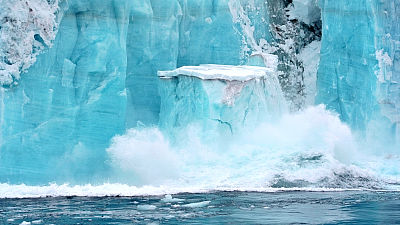A huge crack in the shelf of Antarctica is getting bigger and bigger

ByAnne Fröhlich
The crack that entered Larsen C shelf ice, the fourth largest shelf ice in Antarctica, became enormous, and it turned out that Larsen C was likely to collapse within a few years due to this crack.Larsen Ice ShelfThere are things with a history of 12,000 years, but in recent years the collapse speed has been rising sharply due to global warming on the Antarctic Peninsula.
A huge crack is spreading across one of Antarctica's biggest ice shelves | Toronto Star
https://www.thestar.com/news/world/2016/08/22/a-huge-crack-is-spreading-across-one-of-antarcticas-biggest-ice-shelves.html
Larsen ice shelves are called Larsen A, Larsen B, Larsen C from north to south. It is estimated that Larsen A existed over 2000 years ago, but it collapsed in 1995. Although Larsen B with the history of 12,000 years still exists, it is expected to disappear in 2020.
Antarctica shelf ice is about to end - GIGAZINE

And newly, prediction is made that the crack of Larsen C becomes huge and "Is it not going to disappear soon"? Although cracks that entered Larsen C had been confirmed before, it was reported that the crack length increased by 30 kilometers from 2011 to 2015, and the crack width was 200 meters. And in the observation made in March 2016, it was found that the length of the crack was further extended by 22 kilometers and the width increased to 350 m. As of August 2016 the total length of the crack will reach as much as 130 kilometers.
The rift is likely to lead to an iceberg breaking off, which will remove about 10% of the ice shelf's areaPic.twitter.com/uu1KKWG0WP
- Project MIDAS (@ MIDASOnIce)August 18, 2016
This time I went to observe the Larsen C shelf iceBritish Antarctic SurveyEstablishedMIDASA research group called. Researchers at MIDAS believe that 9-21% of Larsen C shelf ice will be lost in the future due to this crack.
The area of lost ice is about 6000 square kilometers, which isPrince Edward IslandSize larger than. It means that shelf ice for one island will be lost. Professor O'Leary, a glaciologist at the University of Swansea, a member of the research group, said, "It is difficult to accurately predict the timing of the crack propagation is as difficult as the earthquake prediction, and we can not tell when the shelf ice collapse will occur." Although it is not what will occur today tomorrow, it seems that it will see collapse occur within a few years. In addition, there are many researchers seeing that the ice at the head of Larsen C collapses, the remaining shelf ice will become unstable and further collapse will occur.
Larsen B continued to collapse the remaining shelf ice intermittently after the massive shelf ice collapse in the 1980s and shelf ice of 3275 square meters area was lost in 2002 alone. Since the collapse of Larsen C is similar to the collapse of Larsen B, it is a matter of time before Larsen B disappears like Larsen B, which is expected to disappear after a few years.
The sea ice is exposed on the sea as a whole, so the sea level does not rise instantly due to the collapse, but it seems that by raising the speed of the ocean current will eventually promote an increase in sea level It is done. There are also researchers seeing that Larsen C's disappearance will not have a serious effect on the global environment, as there are cases where immediate sea level rise will not result, but the entire Larsen C will collapse There is also a research group that sees that the sea level rises by 10 centimeters, and the influence on the earth is unknown until actual collapse occurs.

ByAmanda Graham
Related Posts:
in Science, Posted by darkhorse_log







